

| |
 Shane Gero |
|
Individuals which live in complex social environments must not only deal with the challenges of the physical environment but must also solve problems related to their social interactions. Therefore, communication is vital to animal survival, yet the functions of most animal communication signals are still speculative; particularly for large whales in the ocean, where identifying the signaller and receiver or the behavioural context of the interaction is challenging. My current research will be the first synthesis between a long-term behavioural study of individual cetaceans and the comprehensive fine-scale data collection of acoustic accelerometer tags. This combined approach will entail the simultaneous placement of Dtags on several strategic members of well-known social units of sperm whales. The resulting mobile acoustic array would effectively record all codas produced by all unit members, as well as their individual orientations in the water column and positions with respect to one another. Combined with the background knowledge of the animals from the last 10 years of my research through The Dominica Sperm Whale Project, I will be able to identify the caller (e.g., Female #5560) for each call type (e.g. Type '5R') as well as their genetic (e.g. aunt) and social (e.g. babysitter) relationship to the respondent (e.g. calf #6068). This study would provide both the social and behavioural context in which vocal exchanges are made between individual whales and allow for the first time for functional interpretation of their vocal signals. In effect, this would be the first study to accurately answer the Who, What, Where, and When questions about vocal exchanges between sperm whales and thereby allowing us to begin to ask Why. A study of acoustic communication at this detailed a level has never been attempted in any species of marine mammal and would stand as a pivotal step forward in our understanding. Insights into the contextual use and syntax of social calls will uncover how large, free-ranging animals coordinate as a group, identify conspecifics, and transfer information. More broadly, this study contributes to our understanding of the coevolution of functionally diverse communication systems and complex societies.
| |
| Acoustic communication in common bottlenose dolphins (Tursiops truncatus) in an urbanized coastal environment Ida Marie Kragh |
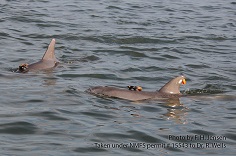
|
Bottlenose dolphins develop individually distinctive signature whistles that they use to facilitate group cohesion and for individual recognition of familiar conspecifics. These animals often live in urbanized coastal environments where ambient noise from abundant watercraft traffic may have deleterious impacts on the acoustic behaviour of bottlenose dolphins, e.g. by preventing detection of whistles from conspecifics. In my master thesis, I will use data from acoustic and movement logging DTAGs deployed on common bottlenose dolphins (Tursiops truncatus) in 2014-2017 in Sarasota Bay (Florida, USA) to investigate how these animals modulate their acoustic output and thus communication range in the field. I will test three hypotheses: (1) Are signature whistles emitted at consistently higher output level compared to non-signature whistles? (2) Do allied males emit signature whistles at higher rates and output level compared to mother-calf pairs? (3) Do bottlenose dolphins modify the output level of signature and non-signature whistles to compensate for increasing ambient noise? Answers to these questions will help us understand the scope that animals have for adapting to increasing underwater noise. | |
| Cognitive Modulation of the Diving Response in Harbor Seals Jeppe Kaczmarek |
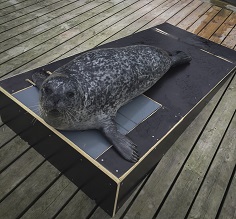 |
There is evidence that harbour seals to some extent have the ability to modulate their heart rate cognitively. I wish to investigate this further by measuring heart rate on trained harbour seals during different settings on land. The experiments are conducted at the Fjord & Bælt center, where we can maintain somewhat constant settings and thereby work with the cognitive aspect of their heart rate. | |
| Acoustic communication in southern right whales Mia Lybkær Kronborg Nielsen |
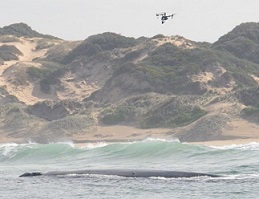 |
Southern right whales (Eubalaena australis) migrate from their feeding grounds in the Antarctic Ocean to lower latitude coastal waters to breed and nurse their calves. While at the nursing grounds the mother and calf pairs generally remain very close to the coast, presumably to avoid predation and attention from males. For the mothers there is a large energetic investment associated with reproduction and raising a calf. While she is at the breeding ground the mother does not feed, and she and her calf both live off of her energy stores. It is therefore extremely important that the mother and calf are able to keep contact in order to assure survival and a healthy development of the calf. But little is known of how the mother and calf communicate and how the suckling is mediated, as well as what might have a negative effect on this communication.
| |
| Acoustic behavior in a bat studied with a tag Laura Stidsholt |
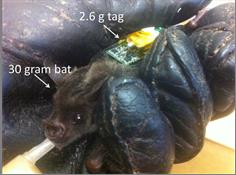 |
Bats echolocate to navigate and to find, discriminate, pursue and catch a prey. In a few milliseconds, the bat has to extract the desired auditory information from the complex scene, and react with a new set of calls and motor responses. Research in the last 50 years has revealed how bats change their biosonar emissions when approaching a target. However, little is known about how bats perceptually organize the very complex barrage of echoes returning to its auditory system when echolocating for prey in the wild. This lack of ecological validity stems from methodological constraints on what can be measured from free flying bats in a complex environment over longer time periods. With this PhD project I will change that by using a newly developed acoustic tag - weighing 2.6 grams - which can be attached on the back of echolocating bats and record the emitted calls and the echoes returning from the environment, concomitant with the movements of the bat. This will allow me to tap into the sensory stream that guide changes on behaviour and vocal-motor patterns of free flying bats echolocating for prey under controlled laboratory settings and in the wild. | |
| Acid-Base balance of marine mammals Niels Kristensen |
 |
The respiratory characteristics of marine mammals have been a topic of interest since early experiments were carried out by Scholander and Irving in early 1940. Many of the following studies investigated how this group of animals could cope with their long periods of apnea, focusing mainly on the investigation of O2 transport and the utilization of anaerobic work. Much less attention though has been given to the characteristics of CO2 transport which are intrinsically coupled to the consumption of O2. As is known from the field of clinical medicine improper orchestration of CO2 transport can lead to severe diseases and death, and so the question arises how do these animals manage the continually metabolic production of CO2 during the periodic breathing lifestyle they have adapted to?
| |
| Acoustic and nursing behavior in humpback whale calves Simone Videsen |
|
The humpback whale, Megaptera novaeangliae, has a cosmopolitan distribution and migrates seasonally from higher latitudes to their wintering grounds in lower latitudes. They fast during these migrations and while on their wintering grounds. These grounds serve as both breeding and calving areas for the humpback whales. The gestation is presumed to last 11-12 months and the calves are weaned, when they are approximately 6 months old. In this study we are focusing on the population migrating along the western coast of Australia.
| |
| Diving response of the Harbour porpoise Siri Elmegaard |
|
All tetrapods share an immediate response to apnoea and submergence in water to conserve blood oxygen for the brain and heart. This response is know as the dive reflex, which is constituted by bradycardia and peripheral vasoconstriction. Marine mammals spend substantial parts of their lives submerged, and thus benefit from modulating this dive reflex to manage oxygen levels optimally according to e.g. the length and activity level of their dives.
| |
| Biosonar dynamics: foraging in a dynamic, multi-target world | |
Chloe Elizabeth Malinka |
|
Foraging toothed whales must be able to distinguish between targets and selectively keep track of prey items whilst in a multi-target and acoustically cluttered environment. Echolocating animals manage sensory loads from complex scenes by controlling the flow of spatial and temporal information via the adjustment of both their beamwidth and acoustic gaze. However, it is not understood how they control their acoustic gaze to inform changes in motor behaviour during search, approach and interception of multiple moving prey targets. Here, I propose to define the basis on which porpoises adjust their acoustic gaze to focus on distinct targets. Specifically, I will test their capability to range and hence delay gate to focus on a target of interest and track moving targets in an environment with a barrage of unwanted echoes. DTAGs will be placed on blindfolded, free-swimming harbour porpoises (Phocoena phocoena) which have been trained to target at Fjord&Bælt. Since echoes reflected from real objects create a specific temporal and spectral pattern, the acoustic scene can be manipulated by projecting acoustically simulated ‘phantom echoes’, giving the experimenter full control over both the echo-generating process and the phantom echo. I will test whether porpoises adjust their biosonar to the target or to the phantom target to uncover whether and when porpoises time-gate to manage their echoic scene by effectively ignoring irrelevant echoes to reduce range ambiguity. Using this phantom target system will allow for quantifying how clutter and multiple targets impact the time resolution capability in the porpoise’s biosonar feedback loop. | |
| 'Head mounted fast recording tri-axial accelerometers to measure behavior of large terrestrial herbivores, in this case the red deer Cervus elaphus Mette Vesterhaab |
|
Measuring continuous animal behavior on free ranging individuals can cause an amount of difficulties. The most commonly known method is to visually observe the animals, however not all animals are easy to follow and the observer may cause the animal to behave differently. Using fast recording tri-axial accelerometers to measure the orientation and the specific acceleration will give a high resolution account of what that tag has experienced. The attachment area on the animal will therefor have a big impact on what the accelerometer will 'see'.
| |
| Echolocation in sperm whales | |
Pernille Tønnesen |
|
Sperm whales (Physeter macrocephalus) use echolocation in order to find food, primarily squids, in the darkness at 500 to 1000 meters depth. The sperm whale is a cosmopolitan species, and therefore encounters a wide range of habitats and different prey types. Hence, groups of sperm whales in different geographical regions might use different foraging strategies in order to adapt to their specific habitat. | |
| Echolocation in sperm whales | |
Anne Bøttcher |
|
Sperm whales (Physeter macrocephalus) live in a multileveled society where individuals are a part of a stable long-term structure called a ‘social unit’. Members of units travel together for life over large distances. Two or more units sometimes socialize for short periods in groups and, at the highest level, dozens of units are members of the same vocal clan. In a vocal clan, all units by definition share a common vocal repertoire of codas that are the primary communication call between sperm whales. Codas are Morse code like stereotyped patterns of clicks. However, it is not understood how individuals use codas to maintain contact and exchange information. Some codas appear to be used in social recognition of individuals, units or clans. Therefore, it is expected that some calls are exchanged over short distances and others over long. The range over which a signal can be detected is called the active space and depends on different parameters, including the source level of the emitted sound, the transmission loss between the signaler and receiver, as well as the detection threshold of the receiver. | |
 Michael Ladegaard |
|
Most toothed whales rely heavily upon echolocation in their search for prey items. The majority of the toothed whales are marine species, but a handful of species have adapted to a life in freshwater river systems. Most models for echolocation in water assume free field conditions in open water with few reflections. River dolphins are examples of species living in habitats where these assumptions are far from being met. Nonetheless do river dolphins, that are often found in murky waters, likely rely more on echolocation than most marine toothed whales where vision is also used for hunting. It therefore seems ironic that toothed whales species for which echolocation is most needed also seem to face the biggest challenges in terms of operating their sonars. Shallow waters present a habitat different from perfect acoustic free field conditions, because reflections from the surface, bottom and vegetation will generate echoes (so-called clutter) that interfere with the weak echoes from prey items. | |
 Line Hermannsen |
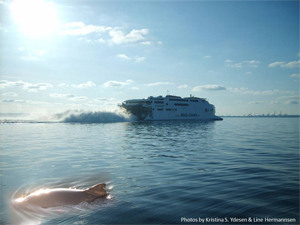 |
Noise has recently been acknowledged as an important source of pollution in EU’s Marine Strategy Directive. Danish waters are heavily ship-trafficked, and shipping noise may affect marine mammals negatively by impeding their use of sounds for echolocation and communication. The scale of impact of anthropogenic ocean noise is difficult to quantify and still largely unknown.
| |
 Danuta Maria Wisniewska |
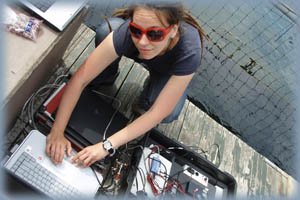  |
Up until recently most underwater biosonar research has focused on how a stationed dolphin can detect stationary objects. These experiments have shown that toothed whales can detect objects at long ranges and discriminate between targets differing not only in shape and size, but also their internal structure and composition. These studies however provide little information on the performance of biosonar systems of animals operating in their natural environments, under different noise and clutter conditions. Furthermore, as shown, inter alia, for humans and bats, auditory perception goes beyond the detection, discrimination and localization of sound stimuli. It requires organization of the extracted acoustic information to allow the listener to identify and track sound sources in the environment, through processes of both auditory scene analysis and auditory selective attention. Finally, biosonar is an active system, where the animal analyses an actively generated auditory scene using echoes of its own signals and has therefore the capability to react to the received information by adjusting both its locomotive and acoustic behaviour.
| |
| Neural and Muscle function in diabetic rodents | |
Jeppe Seamus Bayley |
|
A study on diabetically induced neuropathy and myopathy in rodents. The study investigates a number of aspects of neuromuscular function in the diabetic animal including excitability of the muscle and motor neuron, force production, force-frequency relation, speed of contraction/relaxation and more. | |
 Andrea Fais |
|
The sperm whale (Physeter macrocephalus) hypertrophied nasal sound production apparatus can generate source levels in excess of 230 dB re 1μPa (pp). This makes their echolocation clicks suitable for long-range echolocation. Sperm whale echolocation has been studied for some time, however there is still much to learn about how the whales adapt the way they use their biosonar to exploit different habitats and prey types.
| |